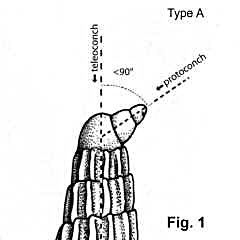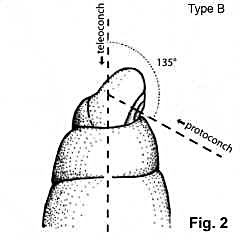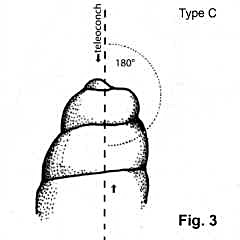|
< Previous family introduction |
|
|||||
|
|
Family Pyramidellidae Pyramid shells
|
|||||

Figs. 1-3. Protoconch types in Pyramidellidae
|
The Pyramidellidae is a large family of marine, ectoparasitic molluscs of worldwide distribution. The shells take a variety of forms from very elongate to ovate, with a variety of sculpture, and usually have a heterostrophic protoconch. There is over 5000 named species, but there is also a large number of unnamed species, possibly more than are named. There are several hundred species in eastern Australia, of which more than 100 are found in NSW. Pyramidellids are external parasites, feeding on a wide variety of invertebrate hosts, particularly polychaete worms. They possess an extensible proboscis at the end of which is a stylet which is used to pierce the skin of the prey. Body fluids are sucked from the prey. One of the most common species in NSW, Pseudoskenella depressa, lives and feeds on the common encrusting tube worm Galeolaria caespitosa, positioning itself near the opening of the tube. When the worm expands it pinnules to feed, the mollusc extends its proboscis and sucks body fluids from the worm. The habitat of pyramidellids follows that of their hosts. There are some intertidal species, but most live subtidally in muddy or sandy situations in which annelid worms are abundant. Very little is known about the precise habitat and hosts of NSW species, as there are few reports of living animals, and most species are only known from empty shells. Pyramidellids are simultaneous hermaphrodites i.e., having both functional male and female reproductive organs simultaneously. During copulation one individual acts as a male and another as a female. Eggs are deposited on the substrate in a mucous envelope or capsule, with free swimming larvae hatching out into the sea. The taxonomy of the family is poorly developed, not only in Australia but world-wide. In Australia, Charles Hedley described species in the early 20th century, followed by Tom Iredale in the mid-20th century, but it was not until Charles Laseron produced a review of the NSW species in 1951 (Laseron, 1951) and of Northern Australian species in 1959 (Laseron, 1959) that more progress was made. Laseron's publications, based on collections made by him and his son John, and illustrated by Laseron's own figures, were a synthesis of existing knowledge and description of dozens of new genera and species. In his 1951 paper of the NSW fauna he introduced 4 new genera and 39 new species, and in his 1959 paper he covered 150 species and 40 genera, mainly new. But in many cases Laseron had only a few specimens available, and was not able to give much distributional information and no habitat information at all. He apparently did not have access to type material outside the Australian Museum and inevitably produced synonyms of some already named species. The names used in this website are those used in the Australian Museum collections in 2017, which are largely the same as those used in the Australian Faunal Directory section on Pyramidellidae (Beechey, Ponder & Hori, 2011) Family References
Coverage Sixty one species of Pyramidellidae are treated here, being all the named species known from NSW for which specimens are available. Judging by the collections of the Australian Museum, there is about a similar number of unnamed species in NSW, but the named species are the most common and recognisable taxa. Most of the remainder are smaller and rarer species, often represented in the collection by just a few specimens. Additional species known from Queensland and Victoria will no doubt be recorded in NSW with further collecting. For discussion of several problematic species see the Coverage page, accessible from the Additional Species link on the plates. The distribution information given here should regarded sceptically. For the large, common species the collection has enough identified specimens to give a broad distribution, but for the remainder, only NSW specimens have been identified in the main, and the complete distribution is unknown. Identification Notes The general shell characters of pyramidellids in NSW are:
Size groupings used in the descriptions for this family:
The heterostrophic protoconch is a general feature of pyramidellids. The term in general means that the protoconch and teleoconch are coiled in opposite directions, but there are different types of coiling within this definition. Protoconchs have been classified as Type A, B or C (Penas & Rolán, 2010). Type A protoconchs (Fig. 1), which I have not seen in NSW pyramidellids, are coiled with several whorls, and form an angle of 90° or less with the teleoconch. Type B protoconchs (Fig. 2) have a low spire of a few whorls, and form an angle of 90° or more to the teleoconch axis. The first whorl of the protoconch may be visible, or the tilt may be so great that the first whorl is concealed. Type C protoconchs (Fig. 3) form an angle of about 180° to the teleoconch, so the nucleus is totally immersed, or infolded, in the first whorl of the teleoconch. About two-thirds of the NSW pyramidellids have type B protoconchs, and the remainder are type C. (Figs. 1, 2, 3 from Peñas, A. & Rolán, E. 2010) The presence or absence of a plait on the columella is the other important recognition feature. Most NSW pyramidellids have a single plait, which may be weak, moderate or strong. In some cases, the plait is only visible deep within the aperture, and may not be seen in the normal apertural view. Assignment of species to genera in the Pyramidellidae The assignment of species to genera in the Pyramidellidae is based almost entirely on shell characters, as the anatomy of most pyramidellids has not yet been studied. The list below characterises the genera used in this work in terms of broad shell characters. In practice, the assignment of species to genera is not clear-cut, as characters are described in the list in broad terms. For example, shells of Agatha are characterised as being large, moderately tall, smooth and shining with one strong plait on the columella, while shells of Syrnola are described as tall and slender, smooth and with one weak plait. The differences between these two genera, in this terminology, is that Agatha shells are large and relatively broad, but in Syrnola they are smaller and slender, but in practice there is no firm line between the genera. Authors have interpreted shell characters in different ways, leading to the assignment of species to genera being very flexible. For example, Laseron (1951) described Syrnola angusta sp. nov, but I refer to this species as Agatha angusta, following the Australian Museum collection. For this reason, there are many differences in generic placement between Laseron (1951) and this work. Genus Agatha
Genus Chrysallida
Genus Cingulina
Genus Colsyrnola
Genus Eulimella
Genus Hinemoa
Genus Megastomia
Genus Miralda
Genus Odostomella
Genus Odostomia
Genus Ondina
Genus Paramormula
Genus Pseudoskenella
Genus Pyrgulina
Genus Rugadentia
Genus Syrnola
Genus Tiberia
Genus Turbonilla
|

